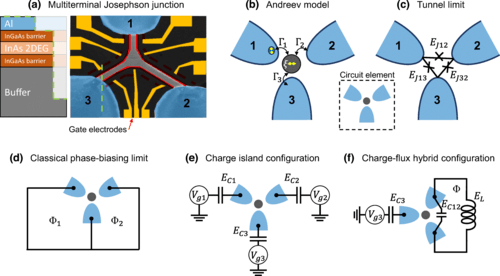Quantum circuits with multiterminal Josephson-Andreev junctions, a type of superconducting quantum circuit, are being explored by researchers from Spain and Argentina. These circuits have multiple connections and their fermionic structure influences the states of the full circuit. The researchers used a simple model to discuss different circuit configurations and found practical applications where the circuits can be used to define noise-protected qubits. These circuits have gained interest with the recent realizations of quantum circuits containing Josephson junctions made out of InAs nanowires and two-dimensional electron gases. The exploration of these circuits’ properties is ongoing, with potential applications becoming clearer as research continues.
What are Quantum Circuits with Multiterminal Josephson-Andreev Junctions?
Quantum circuits with multiterminal Josephson-Andreev junctions are a type of superconducting quantum circuit. These circuits are unique in that they have several leads, or connections, that are simultaneously connected beyond the tunneling regime. This means that the fermionic structure of Andreev bound states in the resulting multiterminal Josephson junction influences the states of the full circuit.
The researchers, FJ MatuteCañadas, L Tosi, and A Levy Yeyati, from the Departamento de Física Teórica de la Materia Condensada Condensed Matter Physics Center IFIMAC and Instituto Nicolás Cabrera Universidad Autónoma de Madrid, Spain, and Centro Atómico Bariloche and Instituto Balseiro CNEA CONICET San Carlos de Bariloche, Argentina, used a simple model of single-channel contacts and a single level in the middle region to discuss different circuit configurations.
The configurations they explored included leads that are islands with finite capacitance and/or form loops with finite inductance. They found situations of practical interest where the circuits can be used to define noise-protected qubits, which map to the bifluxon and 0π qubits in the tunneling regime.
How do Josephson Junctions Work in Quantum Circuits?
Josephson junctions are essential ingredients for turning quantum circuits into artificial atoms. When the degrees of freedom describing the circuit are quantized, the nonlinear, nondissipative Josephson element introduces the anharmonicity in the potential energy that is required to isolate a set of levels for their use as a computational basis.
A conventional tunnel junction is characterized by its charging and Josephson energies, determined respectively by its capacitance and its critical current, which depend on the tunnel barrier and the junction geometry. This description of the junction as a nonlinear inductive lumped element is justified when the energy corresponding to the fermionic excitations of the junction itself is large compared to the lowest circuit levels and thus only bosonic excitations are considered.
More generally, from a mesoscopic perspective, a tunnel junction is just a particular case of a weak link between two superconductors. The coupling being weak, bound states with phase-dependent energies form to accommodate the phase difference between both terminals.
What is the Significance of Quantum Circuits with Multiterminal Josephson-Andreev Junctions?
Quantum circuits with multiterminal Josephson-Andreev junctions have acquired interest with the recent realizations of quantum circuits containing Josephson junctions made out of InAs nanowires and two-dimensional electron gases (2DEGs). These junctions may operate away from the tunneling regime and are better described in terms of high-transmission conduction channels or with a quantum dot model.
The number of channels, the barriers, and chemical potentials can be tuned using gates, thus enabling the realization of devices where the control of the junction parameters is critical. These devices open up the possibility to design hybrid modes combining the fermionic structure of the weak link with the bosonic excitations associated with the electromagnetic collective modes.
This is in line with current efforts towards the physical realization of protected qubits based on the concept of a disjoint support of the qubit wave functions, which enjoy protection against decoherence from one or more noise sources.
What are the Challenges and Opportunities in Quantum Circuits with Multiterminal Josephson-Andreev Junctions?
Quantum circuits with Josephson-Andreev junctions pose basic questions on the proper quantization rules that determine the system Hamiltonian in a general time-dependent situation. For instance, if a time-dependent external flux controls the phase differences, the proper gauge choice becomes a nontrivial issue.
However, these circuits also present opportunities. The presence of a third lead introduces an additional degree of freedom that allows protected qubits to be defined. This is significant as it opens up the possibility of engineering topologically protected singularities in their spectrum and other applications that arise from the introduction of additional leads.
What is the Future of Quantum Circuits with Multiterminal Josephson-Andreev Junctions?
The exploration of the properties of multiterminal Josephson-Andreev junctions when immersed in different kinds of quantum circuits is still ongoing. These are unique mesoscopic components where the weak link connects several superconducting leads that have become experimentally accessible in proximitized 2D structures.
There has been considerable interest in multiterminal Josephson devices driven by the possibility of engineering topologically protected singularities in their spectrum and broadly other applications that arise from the introduction of additional leads. As research continues, the potential applications and implications of these quantum circuits will become clearer.
Publication details: “Quantum Circuits with Multiterminal Josephson-Andreev Junctions”
Publication Date: 2024-05-22
Authors: F.J. Matute-Cañadas, L. Tosi and A. Levy Yeyati
Source: PRX Quantum 5, 020340
DOI: https://doi.org/10.1103/PRXQuantum.5.020340

